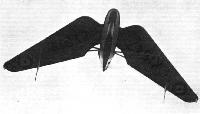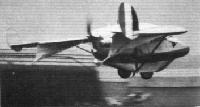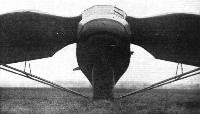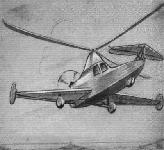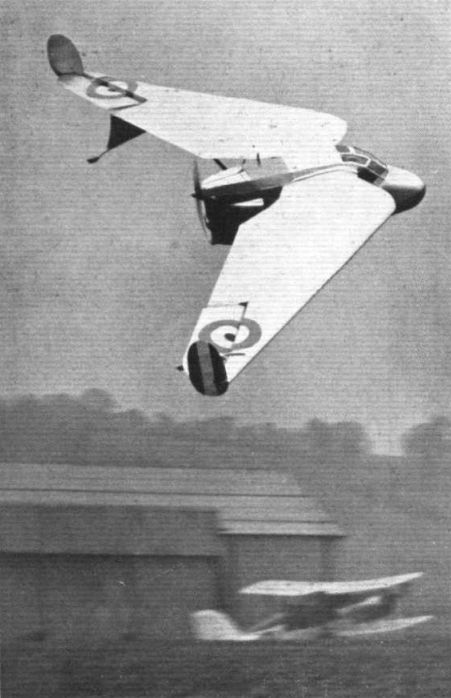
Flight, June 1931
SPECIAL TYPES AT THE DISPLAY
WESTLAND "PTERODACTYL"
THIS machine is a development of the "Pterodactyls" shown at previous Displays. Designed by Captain G. T. R. Hill and built by the Westland Aircraft Works, the Mark IV is a three-seater cabin machine, fitted with the 120-h.p. "Gipsy" inverted engine.
The "Pterodactyl" has no tail, the back-swept wings giving the fore and aft stability attained in orthodox machines by means of a tail. The ailerons perform the functions of fore and aft and lateral control. Used together they act as elevators, while used in opposition they act as normal ailerons. Directional control is by the rudders on the wing tips.
The "Pterodactyl IV" has the inverted "Gipsy III" engine mounted at the back of its fuselage and driving a pusher airscrew. The gross weight is 2,000 lb. (910 kg), and the maximum speed 110 m.p.h. (177 km./h.). The endurance is 4 1/2 hr. at a cruising speed of 90 m.p.h. (145 km./h.).
Описание:
- Flight, June 1931
SPECIAL TYPES AT THE DISPLAY - Flight, December 1931
Pterodactyl
Фотографии
-
Aeroplane Monthly 1981-01 / D.Middleton - Harald Penrose /Test Pilot Profile/ (2)
Регистрационный номер: K1947 [13] The Pterodactyl Mk IV, K1947, was initially flight-tested by L. G. Paget but development flying was continued by Penrose and F. J. Brunton.
-
Flight 1931-12 / Flight
Регистрационный номер: K1947 [13] The large plan view shows the Mk IV cabin variant in flight.
-
Aeroplane Monthly 1973-07 / R.King, H.Penrose - The Ptailless Ones
Регистрационный номер: K1947 [13] The Mk IV appeared as a "new pterror” at the 1932 Hendon Pageant.
-
Aeroplane Monthly 1974-09 / ??? - Hendon Pageantry 1920-37
Регистрационный номер: K1947 [13] THE NEW PTERROR: The Westland Pterodactyl (Gipsy) appeared in new colours for the purpose of monster-chasing.
The latest of the Pterodactyl series, the Mk IV, appeared in a monstrous colour scheme at the 1932 pageant. -
Flight 1931-07 / Flight
Регистрационный номер: K1947 [13] EXPERIMENTAL RESEARCH: THE HANDLEY PAGE "GUGNUNC," THE CIERVA "AUTOGIRO," AND THE HLLL-WESTLAND "PTERODACTYL" IN FLIGHT FORMATION. RIGHT-HAND CIRCUITS WERE MADE SO THAT THE GUGNUNC COULD "MARK TIME" WHILE THE "PTERODACTYL" WENT FULL SPEED.
Другие самолёты на фотографии: Cierva/Avro C.19 - Великобритания - 1929Handley Page Gugnunc / H.P.39 - Великобритания - 1929
-
Flight 1931-12 / Flight
Регистрационный номер: K1947 [13] -
Aeroplane Monthly 1973-07 / R.King, H.Penrose - The Ptailless Ones
Регистрационный номер: K1947 [13] Making a fast flypast, the modified Mk IV displays its wing tip rudders and increased under-wing fin area.
-
Aeroplane Monthly 1973-07 / R.King, H.Penrose - The Ptailless Ones
Регистрационный номер: K1947 [13] The Pterodactyl IV in its first form, before wing-tip rudders replaced the electroscopic type originally fitted.
-
Flight 1931-06 / Flight
Регистрационный номер: K1947 [13] Westland, following upon the Pterodactyl l experience, elected to forego the Mk. II and III projected tailless fighters in favour of the more modest Mk. IV three-seater research vehicle. The sole example, K1947, first flew in June 1931 and was powered by a 120hp DH Gipsy III. The Mk. IV's maximum achievable speed in level flight was 113mph. Interestingly, in an effort to cure the roller-coaster excursions of the Mk. I, Capt. Hill reverted to using elevons on the Mk. IV, in place of swivelling wingtip, but the pitch control problems appear to have remained unaffected.
-
Flight 1931-12 / Flight
Регистрационный номер: K1947 [13] -
Air Enthusiast 1996-07 / A.Pelletier - Towards the ideal aircraft? (1)
Регистрационный номер: K1947 [13] The Westland-Hill Pterodactyl IV was a three-seat cabin machine, powered by a 120hp de Havilland Gipsy III, and was fitted with a completely revised control surface system. During the tests, which spread over several years, the highest incidence reached was 24.5°, but the machine was found to be overweight.
-
Flight 1931-12 / Flight
Регистрационный номер: K1947 [13] -
Flight 1931-11 / Flight
WILL IT COME TO THIS?: A FLIGHT Artist's conception of the result of combining three types which seek to avoid stalling and spinning; the Autogiro, the "Ente" and the Pterodactyl. The name might be something short and snappy, like "Pteroautogirentedactyl."
Другие самолёты на фотографии: Cierva/De Havilland C.24 - Великобритания - 1931Focke-Wulf F 19 Ente - Германия - 1927
-
Aeroplane Monthly 1973-07 / R.King, H.Penrose - The Ptailless Ones
Westland-Hill Pterodactyl Mk.IV
- Фотографии


